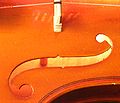Violin
Violin
The violin is a string instrument in the violin family. It is the smallest and highest-pitched instrument in the family in regular use. The violin typically has four strings, usually tuned in perfect fifths, and is most commonly played by drawing a bow across its strings. It can also be played by plucking the strings with the fingers (pizzicato).
History[edit]
The violin first emerged in northern Italy in the early 16th century, especially from the Brescia and Cremona regions. Some of the earliest violins were made by Andrea Amati.
Construction and mechanics[edit]
A violin is usually made from different types of wood, with spruce for the top and maple for the back and sides. The violin bow is typically made from horsehair and Pernambuco wood.
Playing the violin[edit]
Playing the violin involves holding the instrument under the chin, supported by the shoulder. The strings are sounded either by drawing the bow across them (bowing), or by plucking them (pizzicato).
Violin techniques[edit]
Various violin techniques have developed over time, including vibrato, double stopping, harmonics, and col legno.
Violin in music genres[edit]
The violin is used extensively in classical music, folk music, jazz, and rock and roll. It has also been incorporated into some forms of popular music.
See also[edit]
| Violin | ||||||||||
|---|---|---|---|---|---|---|---|---|---|---|
|
-
Violin VL100
-
Range of a violin
-
Gaudenzio Ferrari painting
-
Stainer violin
-
Violin construction
-
Violin
-
Tailpiece and bridge
-
Violin bridge 2 views
-
Soundpost end
-
Violin case owned by Ginger Smock
-
Spectrum of G string
Ad. Transform your life with W8MD's Budget GLP-1 injections from $75


W8MD offers a medical weight loss program to lose weight in Philadelphia. Our physician-supervised medical weight loss provides:
- Weight loss injections in NYC (generic and brand names):
- Zepbound / Mounjaro, Wegovy / Ozempic, Saxenda
- Most insurances accepted or discounted self-pay rates. We will obtain insurance prior authorizations if needed.
- Generic GLP1 weight loss injections from $75 for the starting dose.
- Also offer prescription weight loss medications including Phentermine, Qsymia, Diethylpropion, Contrave etc.
NYC weight loss doctor appointmentsNYC weight loss doctor appointments
Start your NYC weight loss journey today at our NYC medical weight loss and Philadelphia medical weight loss clinics.
- Call 718-946-5500 to lose weight in NYC or for medical weight loss in Philadelphia 215-676-2334.
- Tags:NYC medical weight loss, Philadelphia lose weight Zepbound NYC, Budget GLP1 weight loss injections, Wegovy Philadelphia, Wegovy NYC, Philadelphia medical weight loss, Brookly weight loss and Wegovy NYC
|
WikiMD's Wellness Encyclopedia |
| Let Food Be Thy Medicine Medicine Thy Food - Hippocrates |
Medical Disclaimer: WikiMD is not a substitute for professional medical advice. The information on WikiMD is provided as an information resource only, may be incorrect, outdated or misleading, and is not to be used or relied on for any diagnostic or treatment purposes. Please consult your health care provider before making any healthcare decisions or for guidance about a specific medical condition. WikiMD expressly disclaims responsibility, and shall have no liability, for any damages, loss, injury, or liability whatsoever suffered as a result of your reliance on the information contained in this site. By visiting this site you agree to the foregoing terms and conditions, which may from time to time be changed or supplemented by WikiMD. If you do not agree to the foregoing terms and conditions, you should not enter or use this site. See full disclaimer.
Credits:Most images are courtesy of Wikimedia commons, and templates, categories Wikipedia, licensed under CC BY SA or similar.
Translate this page: - East Asian
中文,
日本,
한국어,
South Asian
हिन्दी,
தமிழ்,
తెలుగు,
Urdu,
ಕನ್ನಡ,
Southeast Asian
Indonesian,
Vietnamese,
Thai,
မြန်မာဘာသာ,
বাংলা
European
español,
Deutsch,
français,
Greek,
português do Brasil,
polski,
română,
русский,
Nederlands,
norsk,
svenska,
suomi,
Italian
Middle Eastern & African
عربى,
Turkish,
Persian,
Hebrew,
Afrikaans,
isiZulu,
Kiswahili,
Other
Bulgarian,
Hungarian,
Czech,
Swedish,
മലയാളം,
मराठी,
ਪੰਜਾਬੀ,
ગુજરાતી,
Portuguese,
Ukrainian










